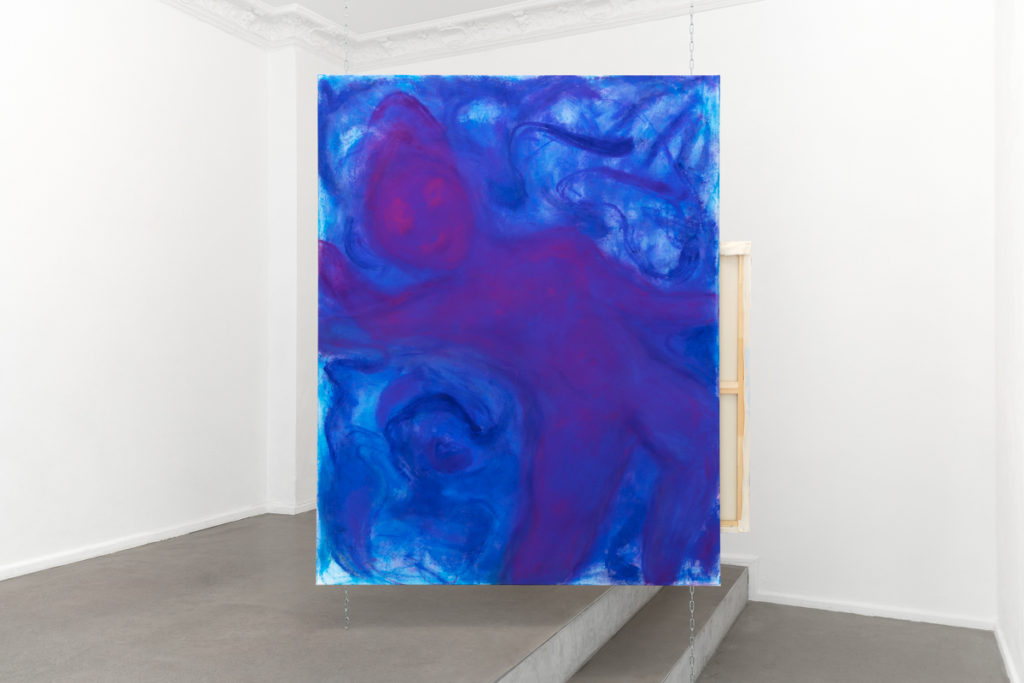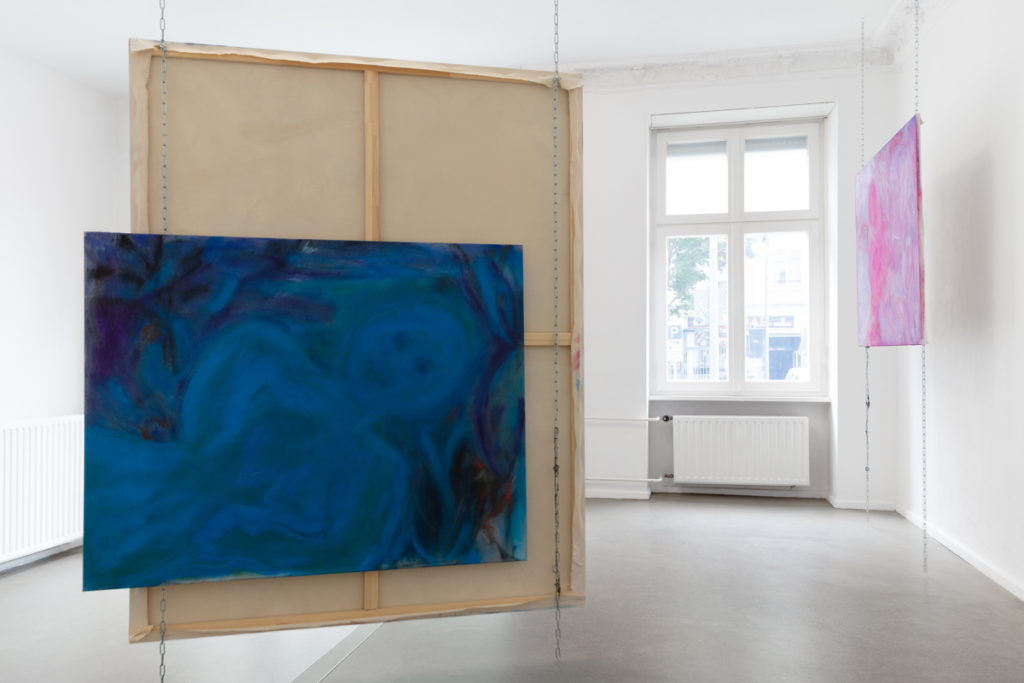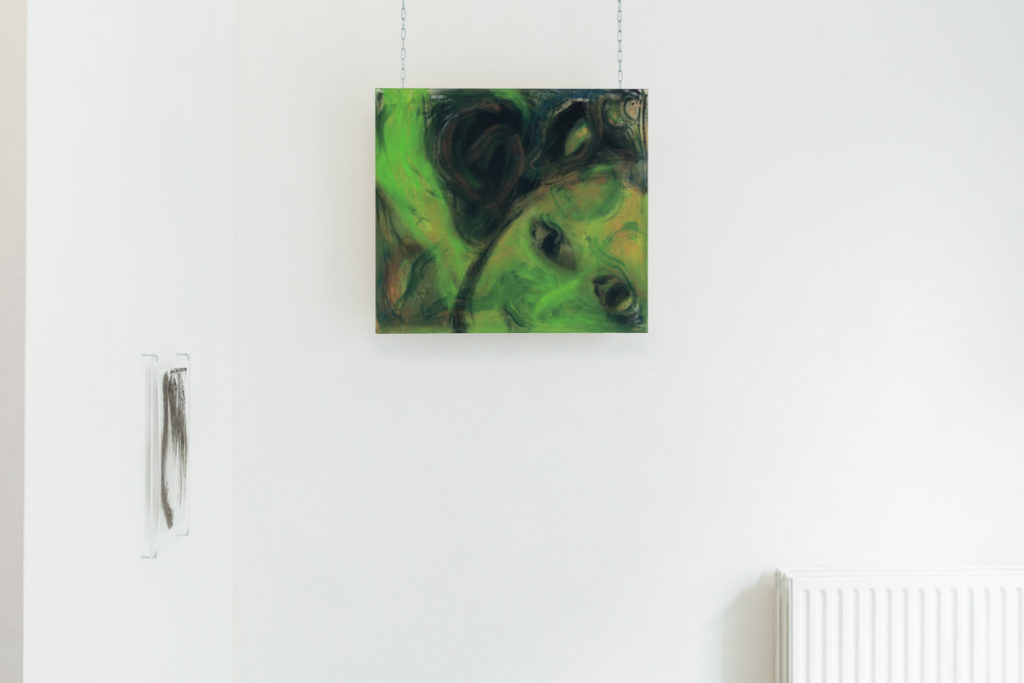DARLING YOU SHOULD FEEL LUCKY
SOLO SHOW
curated by Marie Du Pasquier at Display, Berlin
“The color of that distance is the color of an emotion, the color of solitude and of desire, the color of there seen from here, the color of where you are not. And the color of where you can never go.”[1] If the blue of the sky is the result of the interaction between the sunlight and the molecules and particles of the earth’s atmosphere, it depends as much on our situation and perception. The more the gaze gets away from the light source, the softer becomes the blue of the sky. The blue is the light that gets lost on its way to us, scattering in the atmosphere. In her Essay, Rebecca Solnit emphasizes and repeats: “the blue of distance.”[2] The color is only perceptible because unreachable. Therefore, the blue of longing. The blue of Christina Huber’s painting is the blue of the in-between. The cobalt foundation applied on the primer is the first layer of color, although it might not be the first painting gesture. It is meant to be concealed and yet to seep through and confer this translucent bluish sheen to the ensemble. On this aerial coating, the painted bodies tend to disappear as soon as they take form. “They are the bodies that never appeared and whose “not-appearing” ghost the canvas.” [3] Like remembrances would cease to be as soon as put down on paper, they vanish from the painter’s mind and recall a deeper and unconscious transmission. Christina Huber’s works are made in such a way as to defy the circumscribed corporeality and its social constructs, its systemic bias. The bodies are in constant movement and their pre-defined shapes tend to fade away to rather fill the canvas with ethereal flesh; the figures overflow, intertwine in transparency to let themselves be traversed by the layer’s porosity. Thus they permit us to receive more from the depths and see beyond individuation. “They touch, they fit, they leave, they forget.”[4] The artist exactly explores the body motions and languages, the way bodies act and exchange within spatiality, in relation to the history of their representations and inherited power structures. Her interest lies in scrutinizing the postures, attitudes, gestures and contact-making based on her own research and empirical knowledge. But also, comprised in a participatory and collaborative methodology, she examines her subject through body oriented therapies, dance and choreography. The movements and experiences are shared, integrated, lived, reminded and then transferred on the canvas with walnut oil. And eventually, melting in ultramarine. So they dance these bodies. Together and within. They camouflage, they shapeshift, they smile; they expand in softness. How soft is the contact before the hit of the touch? A kind of softness that we would long for, like the delicate azure reflections of the faraway. Thus a softness far away from any gendered overtone and overrated opinion but rather lingering through the spectrum of possibilities. “Darling You Should Feel Lucky” is an ode to softness and the multiplicity of perspectives. The malleable beings guide us through the exhibition as to enhance its choreographic features. At the threshold of things, they inhabit desire, where we tend to.
Text by Marie DuPasquier
[1] Rebecca Solnit, A Field Guide To Getting Lost, 2017
[2] Rebecca Solnit, Idem
[3] Judith Butler, “Foreword:Bracha’s Eurydice,” in Bracha L. Ettinger, Matrixial Borderspace, 2006
[4] Christina Huber, Notes, 2022
“The color of that distance is the color of an emotion, the color of solitude and of desire, the color of there seen from here, the color of where you are not. And the color of where you can never go.”[1]
If the blue of the sky is the result of the interaction between the sunlight and the molecules and particles of the earth’s atmosphere, it depends as much on our situation and perception. The more the gaze gets away from the light source, the softer becomes the blue of the sky. The blue is the light that gets lost on its way to us, scattering in the atmosphere. In her Essay, Rebecca Solnit emphasizes and repeats: “the blue of distance.”[2] The color is only perceptible because unreachable. Therefore, the blue of longing.
The blue of Christina Huber’s painting is the blue of the in-between. The cobalt foundation applied on the primer is the first layer of color, although it might not be the first painting gesture. It is meant to be concealed and yet to seep through and confer this translucent bluish sheen to the ensemble.
On this aerial coating, the painted bodies tend to disappear as soon as they take form. “They are the bodies that never appeared and whose “not-appearing” ghost the canvas.” [3] Like remembrances would cease to be as soon as put down on paper, they vanish from the painter’s mind and recall a deeper and unconscious transmission. Christina Huber’s works are made in such a way as to defy the circumscribed corporeality and its social constructs, its systemic bias. The bodies are in constant movement and their pre-defined shapes tend to fade away to rather fill the canvas with ethereal flesh; the figures overflow, intertwine in transparency to let themselves be traversed by the layer’s porosity. Thus they permit us to receive more from the depths and see beyond individuation. “They touch, they fit, they leave, they forget.”[4]
The artist exactly explores the body motions and languages, the way bodies act and exchange within spatiality, in relation to the history of their representations and inherited power structures. Her interest lies in scrutinizing the postures, attitudes, gestures and contact-making based on her own research and empirical knowledge. But also, comprised in a participatory and collaborative methodology, she examines her subject through body oriented therapies, dance and choreography. The movements and experiences are shared, integrated, lived, reminded and then transferred on the canvas with walnut oil. And eventually, melting in ultramarine.
So they dance these bodies. Together and within. They camouflage, they shapeshift, they smile; they expand in softness. How soft is the contact before the hit of the touch? A kind of softness that we would long for, like the delicate azure reflections of the faraway. Thus a softness far away from any gendered overtone and overrated opinion but rather lingering through the spectrum of possibilities. “Darling You Should Feel Lucky” is an ode to softness and the multiplicity of perspectives. The malleable beings guide us through the exhibition as to enhance its choreographic features. At the threshold of things, they inhabit desire, where we tend to.
Text by Marie DuPasquier
[1] Rebecca Solnit, A Field Guide To Getting Lost, 2017
[2] Rebecca Solnit, Idem
[3] Judith Butler, “Foreword:Bracha’s Eurydice,” in Bracha L. Ettinger, Matrixial Borderspace, 2006
[4] Christina Huber, Notes, 2022






